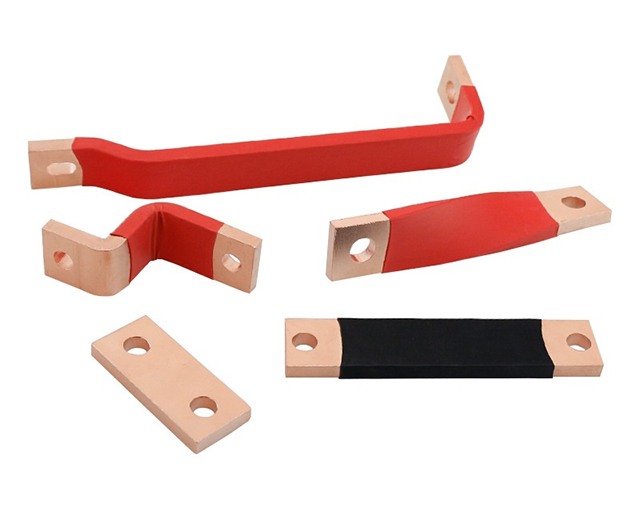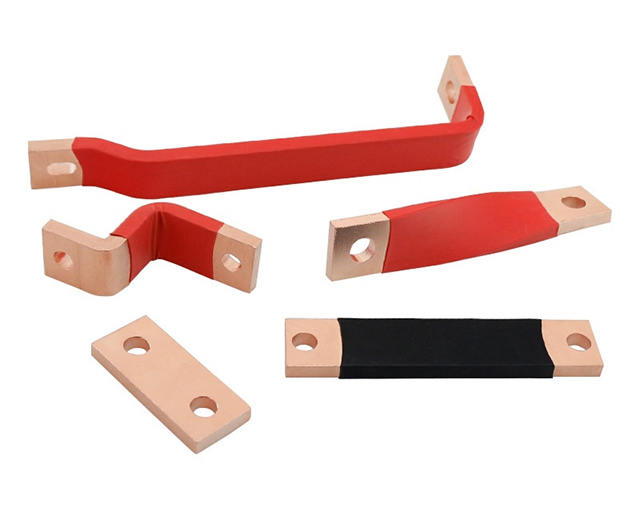

Copper Busbar insulation refers to specialized dielectric materials applied to Copper Busbars to prevent electrical leakage, short circuits, and physical damage while maintaining optimal thermal and electrical performance. These insulation systems may include heat shrink tubing, epoxy coatings, or multi-layer jackets, with thicknesses ranging from 0.2mm to 3.0mm depending on voltage requirements.
Modern materials provide dielectric strengths between 15–40 kV/mm, and thermal conductivity values between 0.2–0.5 W/m·K, ensuring insulation performance without hindering heat dissipation.

The manufacturing process involves:
Busbar Preparation: Copper bars are precision-cut and surface treated.
Insulation Application:
Heat shrink tubing
PVC sleeves
Epoxy powder coatings (electrostatic spraying + curing)
Quality Testing:
Dielectric strength testing
Partial discharge evaluation
Thermal cycling and resistance checks
Each product is designed to meet electrical, mechanical, and environmental standards such as UL94 V-0, IEC 60695, and insulation classes from B to H.
Copper busbar insulation is widely applied in:
Power Distribution Systems (3.6–36kV)
Renewable Energy Installations (solar, wind, 1000V DC)
Transportation Electrification (railway, EV battery packs)
Industrial Machinery (CNC, motor control, 600–1000A)
Data Centers (DC busways, CTI > 400V)
It ensures electrical isolation, mechanical protection, and compliance with global standards in compact and high-load systems.
| Feature | Value / Description |
|---|---|
| Dielectric Strength | 20–35 kV/mm |
| Temperature Resistance | 105°C to 180°C (Class B–H) |
| Partial Discharge Voltage | >1.5× rated system voltage |
| Surface Resistance | >10¹² Ω at 500V DC |
| Thermal Cycling | 1000+ cycles between -40°C to +120°C |
| Flame Retardancy | UL94 V-0 / IEC 60695 compliant |
| UV Resistance | >90% retention after 25 years |
| Thermal Conductivity | 0.2–0.5 W/m·K (with insulation) |
| Vibration Resistance | 10–15G (transportation-grade silicone insulation) |
Designing effective insulation includes:
Voltage Rating: Select proper thickness and material for dielectric strength
Current Load: Ensure the insulation supports current density (3–5 A/mm²)
Environment: UV exposure, altitude (>2000m), humidity, or vibration
Color Coding: For phase marking in panels (R/Y/B/GN)
Space Efficiency: Thin yet robust insulation for compact layouts
Standards Compliance: UL, IEC, RoHS, and fire-resistance requirements
For complex systems like switchgear, wind turbines, or data centers:
Use anti-corona designs in high-altitude installations
Ensure partial discharge control (<5pc at="" 1.1="">
Maintain creepage distance: 8–12mm/kV in high-pollution zones
Select UV-stable coatings for solar DC busbars
Provide thermal dissipation paths (e.g., copper-air conduction + insulation spacing)
G and N Fortune Limited delivers premium copper busbar insulation solutions trusted across global industries. Here's why:
Customized Design: Tailored voltage class, insulation thickness, material type
Certified Quality: UL, CE, RoHS, and ISO-compliant products
Bulk Manufacturing: Scalable supply for OEM and turnkey projects
Material Variety: PVC, epoxy, heat shrink, silicone, etc.
End-to-End Support: From design consulting to after-sales service
Strict Testing: Insulation resistance, dielectric withstand, thermal cycling
Application Expertise: Solutions for energy, EV, automation, and rail sectors
Copper Busbar Insulation – FAQ
A1: Our copper busbar insulation systems support voltage ratings from 400V to 36kV, with dielectric strengths up to 35 kV/mm. Custom solutions are available for both low-voltage and medium-voltage systems.
A2: We offer various materials to suit different environments and applications, including:
PVC (Polyvinyl Chloride) – economical and flame-retardant
Heat Shrink Tubing – for precise fit and strong adhesion
Epoxy Powder Coating – durable, chemical-resistant
Silicone-Based Insulation – ideal for high-vibration and high-temperature environments
XLPE (Cross-linked Polyethylene) – excellent thermal and electrical resistance
A3: Yes. Our insulation is designed for outdoor durability, featuring UV resistance and anti-corona designs. Products for high-altitude applications (up to 4000 meters) meet partial discharge and creepage distance requirements.
A4: With proper installation and routine maintenance, our copper busbar insulation can last 20 to 25 years or more, depending on environmental exposure and loading conditions.
A5: Use non-amine-based cleaning agents with lint-free wipes (≤70% alcohol). For moisture-sensitive environments, dry at 60–80°C after cleaning. Avoid high-pressure cleaning (>0.3 MPa) to prevent damage.
A6: All products are tested for:
Insulation Resistance (>100 MΩ at 1000V DC)
Dielectric Withstand Voltage (2× rated voltage + 1000V for 1 min)
Partial Discharge (<5pc at="" 1.1="">
Thermal Cycling (1000+ cycles between -40°C and +120°C)
Flame Retardancy (UL94 V-0 / IEC 60695 compliant)
A7: Yes, we support customized copper busbar insulation solutions including size, shape, insulation material, and color coding. We can accommodate specific OEM and project-based requirements.
A8: Our insulated copper busbars comply with UL, CE, RoHS, and IEC standards. Detailed test reports and certification documents can be provided upon request.